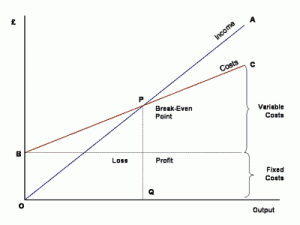 Break-even point is one of the most significant business ratios, knowing and understanding will keep you out of trouble. It is the point at which you neither make a profit nor a loss. A lot of business people regard this as a bottom up exercise (once Sales reach £2M the company will start making profits). I prefer to see it as a fallback position (the break-even point is reached at 78% of forecast sales). That means to say sales can fall by 22% before losses are incurred.
Break-even point is one of the most significant business ratios, knowing and understanding will keep you out of trouble. It is the point at which you neither make a profit nor a loss. A lot of business people regard this as a bottom up exercise (once Sales reach £2M the company will start making profits). I prefer to see it as a fallback position (the break-even point is reached at 78% of forecast sales). That means to say sales can fall by 22% before losses are incurred.
A lot of companies operate at a 90% break-even point which some regard as the happy fool territory. How easy is it to lose 10% of your turnover? If you are honest, the sales forecast was on the ambitious side to start with and there was no contingency in your expenses budget. 10% could be lost before you start. 20% to 25% is the territory to be in. How many large corporations do you see making losses in this recession? Not many, their profits are squeezed but they are not going to go into liquidation.
The diagram explains simplistically how it works. Examples of fixed costs would be; rent and rates, light and heat, advertising etc., variable would be; raw materials and direct labour. The problem comes when business is in decline because some of the variable costs, in particular direct labour (such as designers, surveyors or engineers) turn out in reality to be fixed for a considerable period of time until the business can adjust and shed excess capacity. When business is on the upturn, consider temporary staff until you are sure that the new higher level is sustainable.


